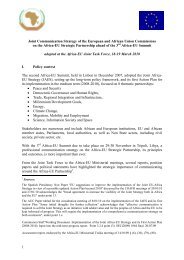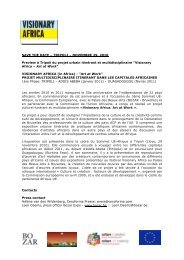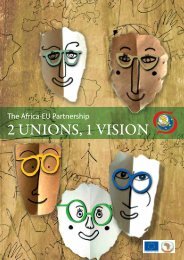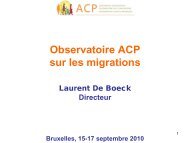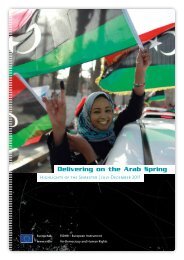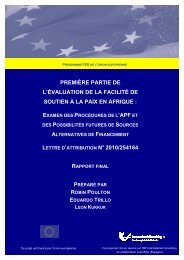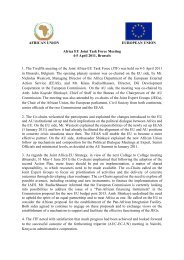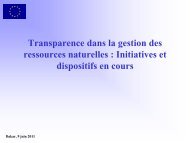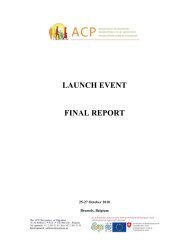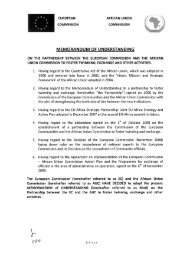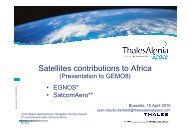part 1 of the african peace facility evaluation - European ...
part 1 of the african peace facility evaluation - European ...
part 1 of the african peace facility evaluation - European ...
Create successful ePaper yourself
Turn your PDF publications into a flip-book with our unique Google optimized e-Paper software.
At first sight, <strong>the</strong> Instrument for Stability seems to be a potential <strong>part</strong>ner for APF. Yet, <strong>the</strong> analysis<br />
reveals too many legal and procedural discrepancies to make this feasible. IfS has grown to be more<br />
valuable, moving from <strong>the</strong> small, six-month Rapid Reaction Mechanism to a substantial instrument<br />
with crisis response capacity and 18-month (extendable) interventions. But <strong>the</strong> restrictions on time, its<br />
global mandate and <strong>the</strong> impossibility to fund anything but ‘military’ actions give <strong>the</strong> IfS a pr<strong>of</strong>ile that is<br />
very different from <strong>the</strong> long-term, sustainable, pan-Africanist APSA and PSO-oriented APF. However,<br />
procedural innovations are developed by IfS, which, if applied to APF, would make it a more flexible<br />
and efficient instrument. These are explained in more detail in Annex 3.4.<br />
THE ATHENA DECISION,<br />
The ATHENA Decision presented in Annex 3.5, <strong>of</strong>fers EU MS an innovative military funding<br />
mechanism outside <strong>the</strong> EU budget. It could possibly be adapted to create an A<strong>the</strong>na mechanism for<br />
Africa. However, significant changes to <strong>the</strong> existing model would be necessary to ensure ‘predictable<br />
funding’ (A<strong>the</strong>na is funded annually on a needs-basis) and allow for African leadership. The A<strong>the</strong>na<br />
Decision is <strong>the</strong> odd-one-out in <strong>the</strong> list, used by EU MS to create a mechanism outside <strong>the</strong> EU budget,<br />
for <strong>European</strong>-led military operation funding on an annual budget basis. Its potential magnitude,<br />
flexibility and military components make it an attractive option to fund or replace APF funding <strong>of</strong> PSOs,<br />
but it may be difficult to adapt it to African use because AU administrative management and control<br />
procedures are still weak. However, <strong>the</strong> A<strong>the</strong>na Decision demonstrates EU MS creativity in<br />
responding to security needs.<br />
VOLUNTARY CONTRIBUTIONS FROM EU MS<br />
Under annex II <strong>of</strong> <strong>the</strong> APF regulations, when one PSO requests additional APF funds, <strong>the</strong> EC can ask<br />
Member States for additional voluntary contributions. This has been done in <strong>the</strong> past, as an innovation<br />
under <strong>the</strong> 9 th EDF (when eight MS contributed to AMIS). By <strong>the</strong>ir very nature, however, AVCs cannot<br />
be considered as ‘predictable and sustainable funding’.<br />
The fact that several EU MS have established <strong>the</strong>ir own P&S funds (Italy, Spain, Denmark) points to<br />
<strong>the</strong> political nature <strong>of</strong> support to African Peace and Security efforts as well as a certain reluctance<br />
among certain EU member states to put all <strong>of</strong> <strong>the</strong>ir eggs in one basket. Coherence and synergy<br />
should start within <strong>the</strong> EU. The existence <strong>of</strong> small, rival, bilateral APFs seems inconsistent, now that<br />
<strong>the</strong> EEAS has been set in motion to bring coherence to EU foreign policy in Africa. This is discussed in<br />
Annex 3.7.<br />
MIXED OPTIONS:<br />
It would be possible to cobble toge<strong>the</strong>r a combination <strong>of</strong> EDF financing <strong>of</strong> ‘s<strong>of</strong>t elements’ (i.e. nonmilitary<br />
expenses) if EU MS decided to abandon <strong>the</strong> development-security nexus and refuse EDF<br />
funds for PSOs. In this case, some ad hoc CFSP funding (for military hardware and/or big PSOs)<br />
might be possible. However, no EU funding instrument, a<strong>part</strong> from APF, would include African<br />
ownership and African leadership in military <strong>peace</strong> operations.<br />
THE DCI BUDGET<br />
The DCI Budget <strong>of</strong> €16.9 billion for <strong>the</strong> period 2007-2013, is more substantial than o<strong>the</strong>r CFSP or IfS<br />
budgets. The APF could be included if <strong>the</strong> rules allowed DCI to fund APF activities and APSA. Yet, <strong>the</strong><br />
PSO <strong>part</strong> cannot be covered under DCI rules. Actions such as capacity building (non-military),<br />
mediation, Early Response Mechanism, early warning, conflict management and <strong>the</strong> Panel <strong>of</strong> <strong>the</strong><br />
Wise could possibly be funded under DCI, which can <strong>of</strong>fer assistance in post-crisis situations and to<br />
fragile States and fund international organisations. It is unlikely that such a change would add any<br />
significant added value, however Annex 3.6. provides a detailed summary <strong>of</strong> <strong>the</strong> possibilities for DCI<br />
and Mixed Options.<br />
Page 41 <strong>of</strong> 49




